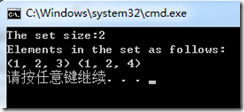在以前学习STL的时候,曾经学到过,如果要将自定义的类型放入到set中的话,就需要重载“<”符号,原因是set是一个有序的集合,集合会按照“<”比较的大小,默认按照从小到大的顺序排列。假设我现在设计如下类型:
class MyType { public: int a, b, c; }
这是,为了让MyType类型可以顺利的放进set中,我必须重载“<”,这时问题来了,要如何重载呢?这个类型有三个数据成员,我能不能要求按照a的大小排列,如果a相等的话就随便按照b或者c的大小排列呢?如果近实现按照a的大小排列的话,重载函数如下:
bool operator<(const MyType& myType) const { return a<myType.a; }
看起来简单明了,但是事实真的是这样吗?如果我声明一个set,并在其中放入MyType(1,2,3)、MyType(1,2,4)我能成功吗?实验了一下,结果如下:
测试时用的代码是这样的:
#include<iostream> #include<set> using namespace std; class MyType { public: int a, b, c; MyType(int a, int b, int c):a(a), b(b), c(c){} bool operator<(const MyType& myType) const { return a<myType.a; } }; int main() { set<MyType> se; MyType type1(1,2,3); MyType type2(1,2,4); se.insert(type1); se.insert(type2); cout<<"The set size:"<<se.size()<<endl; cout<<"Elements in the set as follows:"<<endl; for(set<MyType>::iterator it = se.begin(); it != se.end(); it++) { cout<<"("<<it->a<<", "<<it->b<<", "<<it->c<<") "; } cout<<endl; return 0; }
结果很明显,当我已经把MyType(1,2,3)放到set中之后,就不能把MyType(1,2,4)放进去了。但是为什么呢?这两个对象看起来确实不一样啊!STL在比较是否相同的时候不是要比较每一个数据成员的吗?从上述的例子中,看到的确实不是这样的,STL不会自动的做任何比较,它仅对你说明过的动作干一些指定的活儿。在重载“<”的时候,当只指定众多数据成员中的一部分的时候,如果这部分都相同的话,set就认为是同一个元素了。就如上述所示一样,重载的时候仅作了a的比较,而没有说明如果a相同的话,是否对剩下的元素进行比较。这样一来,set认为MyType(1,2,3)和MyType(1,2,4)是一样的。要让set正确的进行大小的比较,针对自定义类型,就必须说明所有的数据成员的比较情况。如上述的例子的“<”重载,应该这样写:
bool operator<(const MyType& myType) const { return a<myType.a?true:(b<myType.b?true:c<myType.c); }
这样一来,就完全说明了每一个数据成员的比较关系,set就可以正常工作了。还是MyType(1,2,3)、MyType(1,2,4)两个元素,这回运行的结果如下:
运行代码为:
#include<iostream> #include<set> using namespace std; class MyType { public: int a, b, c; MyType(int a, int b, int c):a(a), b(b), c(c){} bool operator<(const MyType& myType) const { return a<myType.a?true:(b<myType.b?true:c<myType.c); } }; int main() { set<MyType> se; MyType type1(1,2,3); MyType type2(1,2,4); se.insert(type1); se.insert(type2); cout<<"The set size:"<<se.size()<<endl; cout<<"Elements in the set as follows:"<<endl; for(set<MyType>::iterator it = se.begin(); it != se.end(); it++) { cout<<"("<<it->a<<", "<<it->b<<", "<<it->c<<") "; } cout<<endl; return 0; }
原文转自 http://www.cnblogs.com/malloc/archive/2012/03/13/2394719.html

